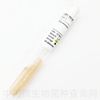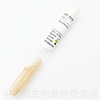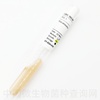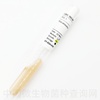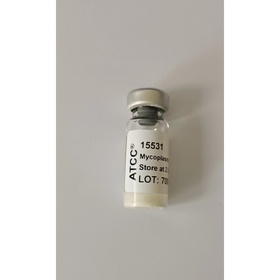
产品详情
平台编号:Bio-121076
Geobacter lovleyi 拉丁名
ATCC BAA-1151 编号
Product type Extremophile
Strain designation 菌株别名 SZ
Type strain 模式菌株 Yes
Genome sequenced strain Yes
Isolation 分离源 source Su-Zi Creek Geographical isolation South Korea
Product format 提供形式 Freeze-dried
Storage conditions 保藏温度 2°C to 8°C
Specific applications Dechlorinates polychloroethylenes (PCE) Reduces iron (ferric, FeIII) ferric iron
Preceptrol No
Extremophile type Metallotolerant
Comments Genome sequenced strain
Medium 培养基 ATCC Medium 2635: Desulfuromonas michiganenesis Medium
Temperature 培养温度 26°C
Atmosphere 需氧情况 80% N2, 20% CO2
Handling procedure Sterilize the top of the Balch tube by spraying with 70% ethanol and then flaming If needed, exchange the gas in the test tube for 80% N2-20% CO2.
Supplement the media with 200 µL per 100 mL PCE and 100 µL per 10 mL of fumarate.
When the Balch tube is ready to inoculate, open the vial according to enclosed instructions. For inoculation, use an anaerobic 1.0 mL syringe tipped with 22-gauge needle.
Withdraw 0.5 mL of #2635 broth and use this to rehydrate the entire freeze-dried pellet. Immediately place the rehydrated vial under a gentle stream of sterile oxygen-free gas.
Using the same syringe, transfer the rehydrated cell suspension to a tube of # 2635 broth.
Plate 0.1 mL of the inoculated culture onto a non-selective medium and incubate aerobically at 26°C.
Use 0.1 mL of the inoculated culture to inoculate a nonselective aerobic broth and an additional tube of #2635 broth.
Incubate the broth tubes at 26°C. Growth should be detected in the #2635 broth within 2 weeks.
There should be no growth detected on the aerobic plate or in the aerobic broth. Handling notes After two weeks of incubation, growth can be viewed as motile rods in a wet mount.
The broth will not become turbid. An “oil slick” may form at the surface of the broth due to the addition of PCE.
This organism is capable of degrading a common groundwater contaminant by completely dechlorinating tetrachloroethene (PCE).
Growth on PCE yields very low cell numbers, but when supplemented with 10 mM fumarate, cell yields are much higher.
Growth on media lacking PCE may decrease the cells’ ability to dechlorinate PCE.
Deposited as Geobacter lovleyi Depositors Y Sung Type of isolate Environmental Year of origin 2003 Special collection NSF - Bacteriology
Cross references 参考文献 GenBank CP001089 Geobacter lovleyi SZ, complete genome.

